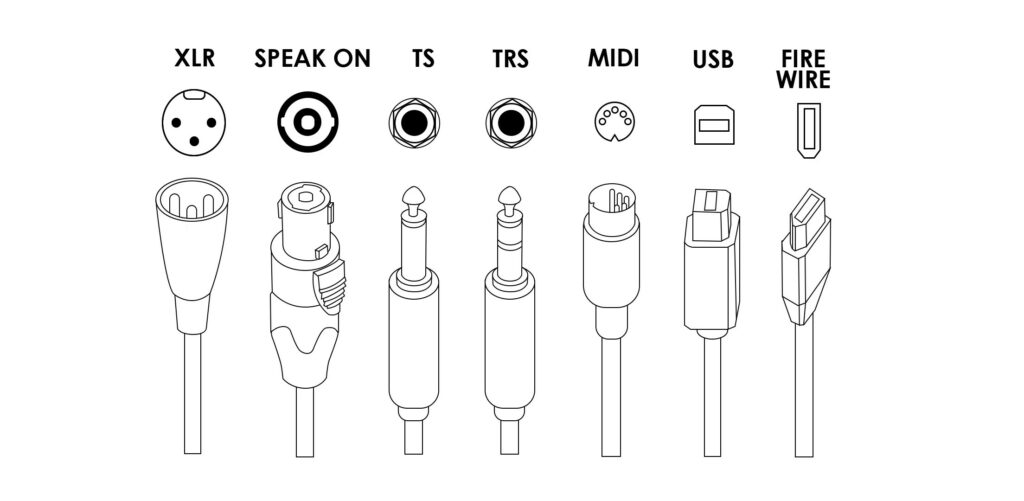When connecting audio equipment, having the right cables and adapters is essential for getting the best sound quality possible.
However, there may be times when you don’t have the exact cable or adapter you need for a particular setup.
In cases where TS cables are unavailable, it may be tempting to use TRS cable as an alternative for carrying audio signals between locations.
However, it is essential to be aware that using TRS instead of TS has certain limitations and drawbacks that should be considered.
When using a TRS cable with a TS jack, the audio signal may be unbalanced.
This presents an issue since unbalanced audio signals are more vulnerable to electromagnetic interference from external noise sources – especially long cables – leading to distortion and noise in the signal, ultimately resulting in poorer audio quality.
Using a TRS cable instead of a TS cable may reduce its durability and lead to connection problems.
This makes the connection less reliable and of inferior quality, ultimately impacting the audio system’s overall performance.
Although using a TRS cable instead of a TS cable is possible, it’s essential to be aware of the potential limitations and drawbacks that this could entail.
Overview Of TS Cable
TS Cable stands for tip-sleeve cable. A TS cable comprises two contact points: the Tip (T) and Sleeve (S).
The audio signal is transmitted through the Tip using its signal wire, while ground wiring that shields against interference passes through the Sleeve.
TS cables are frequently used for connecting instruments like keyboards, guitar effects patch cables, electric guitars, etc.
They may be called mono cables due to their ability to transmit only one signal; thus, if you wish to utilize TS cables for the stereo audio output, you must use two separate cables. Unbalanced TS cables transmit audio directly from a mixer or receiver to any connected equipment – an instrument, mixer, receiver, or computer.
While this makes setup simpler and more affordable, it also increases the risk of distortion or noise in the signal.
When using TS cables, the longer their length is, the greater the potential for noise and interference issues.
Keeping your cable length below 20 feet is recommended to reduce these chances.
Overview Of TRS Cable
TRS stand for Tip, Ring, and Sleeve Cable. TRS cables consist of three contact points – the Tip (T), Ring (R), and Sleeve (S).
The additional contact point is crucial for a balanced audio signal. Hence, these cables are also referred to as “balanced TRS.”
The positive wire is connected to the Tip, and the negative wire is connected to the Ring.
Both wires capture any external noise and interference as the audio signal passes through. However, since the wires have opposite polarities, the noise is canceled, resulting in a clear, clean, and pure audio signal.
Unlike TS cables, TRS cables can be used with mono and stereo signals, making them ideal for use with headphones and other equipment requiring balanced connections.
They are also a safer choice when connecting equipment to multiple devices.
Additionally, TRS cables can work with mono balanced, unbalanced mono, etc., removing the guesswork of selecting the right connectors for the correct channel.
Application Of TS And TRS Cable
TS cables are commonly used to connect electric guitars and basses to an amplifier.
While it’s technically possible to use a TRS cable to connect a guitar to an amplifier, exceeding a distance of twenty feet is not recommended.
TS and TRS cables are often referred to as mono cables or stereo cables.
Another way to describe these cables’ connections is to say that they are either unbalanced (one-way connection, like a TS cable) or balanced (two channels, such as a TRS cable). Headphones, audio mixers, and synthesizers generally use TRS cables.
TRS cables are also better suited for connecting equipment to multiple devices. They are typically referred to as balanced or stereo signals.
One significant advantage of TRS cables is that they simplify cable selection. Additionally, only one cable is required for stereo use.
What Will Occur If I Insert A TS Plug Into A TRS Jack?
If you plugged a TS plug into a TRS balanced jack socket, the “ring and sleeve” will be bridged. This is an appropriate way to unbalance a balanced connection; the cable will still carry audio data but its output will be unbalanced.
However, it’s essential to remember that by unbalancing the output connection, the output level will be reduced by 6dB.
Though this may not seem like much, you’ll notice a difference in volume.
Furthermore, unbalanced signals tend to be more susceptible to noise and interference than balanced ones are.
Connecting a TS plug into a TRS balanced jack socket may work, but the sound quality may not be optimal.
Always use an appropriate cable to guarantee the highest possible audio signal quality.
Is It Possible To Utilize A TS Cable In A Balanced Output?
TS cables are typically used to transmit mono, unbalanced signals – like those from electric guitars – while TRS cables can carry mono, balanced signals and stereo audio output.
A mono-balanced signal would be the line in or out from your audio interface; however, using a TS cable in a balanced output may result in an unbalanced connection that causes noise and interference issues.
To guarantee a balanced connection and minimize any potential noise issues, it is recommended to use either an additional conductor on either end of your TRS cable or balanced TS cable.
What Type Of Cable Do Guitarists Typically Use For Their Instruments?
Guitar cables are TS, or Tip Sleeve cables, which feature a TS jack plug at the top.
The tip refers to the pointed metal portion at the end of the jack, while the long metal shaft is known as the sleeve.
This type of cable is commonly used for transmitting mono, unbalanced signals and is suitable for connecting an electric guitar or other similar instruments to an amplifier or effects pedals. TRS cables, on the other hand, can transmit mono, balanced signals, and stereo signals and are not typically used for guitars unless they require a balanced connection.





